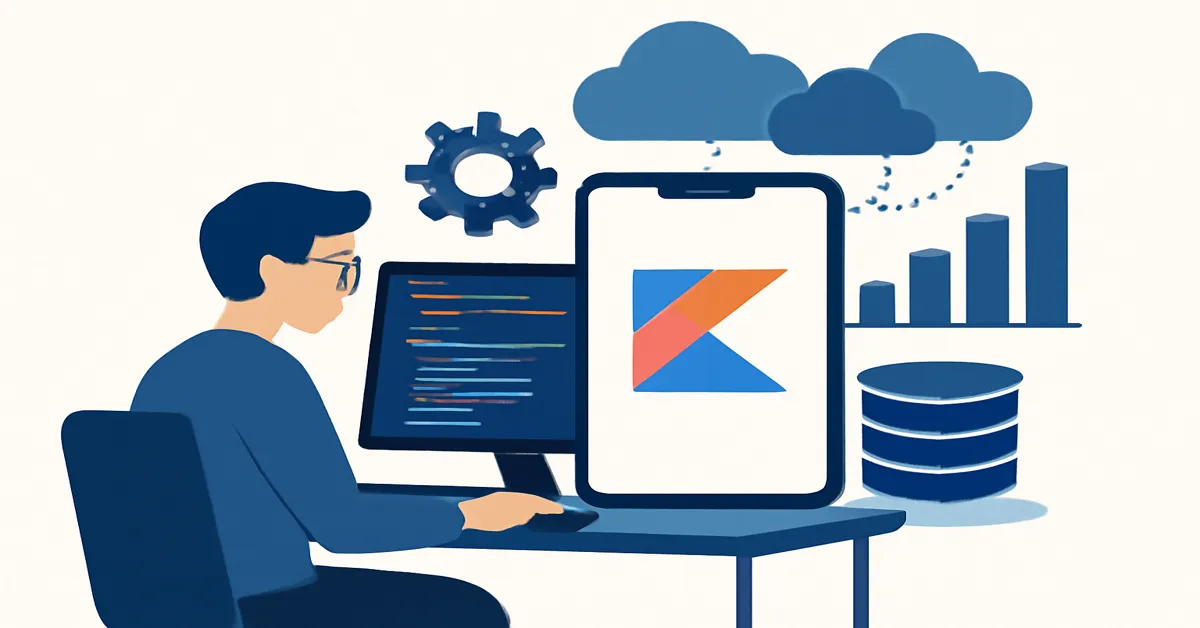In an era defined by rapid digital transformation, building software that can effortlessly scale to millions of users is no small feat. Our journey in creating a scalable Kotlin app, designed to handle millions of simultaneous users, has been a compelling case study in software architecture, engineering discipline, and continuous iteration. This article walks you through the strategic decisions, technical challenges, and innovative solutions that allowed us to build an app that not only meets high demand but also delivers an exceptional user experience consistently.
The Rise of Kotlin in Modern App Development
Before diving into the architecture and scaling strategies, it’s important to understand why Kotlin became our technology of choice. Introduced by JetBrains in 2011 and officially supported by Google as a first-class language for Android development in 2017, Kotlin has rapidly evolved into a favorite for many developers. Its concise syntax, safety features, and seamless interoperability with Java make it an ideal choice for large-scale applications.
Unlike some languages that emphasize speed or ease of writing code in isolation, Kotlin balances productivity and robustness, reducing boilerplate code without sacrificing performance. For a project anticipating millions of users, the combination of developer productivity and runtime efficiency is critical.
Understanding Scalability: What Does It Mean?
At its core, scalability refers to an app’s ability to handle growing amounts of work or its potential to be enlarged to accommodate growth. For us, that meant ensuring the app could smoothly serve millions of concurrent users without degrading in speed or reliability.
Two primary types of scalability informed our design decisions:
- Vertical scalability: Enhancing a single server’s capacity by adding more resources like CPU, RAM, or faster storage.
- Horizontal scalability: Adding more servers to distribute the load and prevent any single point from becoming a bottleneck.
While vertical scaling is often simpler, it hits limits quickly. Horizontal scaling, especially in cloud-native architectures, offers the resilience and flexibility needed to handle massive traffic surges. Our app’s architecture prioritized horizontal scaling as a long-term strategy.
Architecting for Scale: The Blueprint
1. Modular Microservices
A monolithic architecture is straightforward initially but becomes increasingly difficult to maintain and scale as an app grows. We adopted a microservices approach, breaking the application into distinct, loosely coupled services. Each service encapsulated a specific business capability—such as user authentication, content management, notifications, or payments.
This modularization allowed us to scale individual services independently based on demand. For example, during peak times, the notification service could be scaled out without over-provisioning the entire system.
2. Kotlin for Backend Services
Though Kotlin is popular on Android, its use in backend development is gaining momentum, especially with frameworks like Ktor and Spring Boot supporting Kotlin seamlessly. We chose Kotlin for our backend microservices because:
- It reduces boilerplate code.
- Provides excellent support for coroutines, enabling efficient asynchronous programming.
- Ensures interoperability with existing Java libraries and infrastructure.
- Improves code maintainability with type safety and null safety features.
Using Kotlin coroutines, we were able to handle asynchronous I/O operations with minimal thread blocking, increasing throughput and responsiveness.
3. API Gateway and Load Balancing
To direct incoming traffic to the appropriate microservices, we deployed an API gateway layer. This gateway handled request routing, authentication, rate limiting, and response caching, acting as the entry point for all user requests.
Behind the gateway, load balancers distributed traffic evenly across service instances to prevent overload and ensure redundancy. This setup reduced latency and improved fault tolerance.
4. Database Strategy: Combining SQL and NoSQL
Data storage at scale requires thoughtful consideration. We adopted a polyglot persistence approach:
- Relational Database (PostgreSQL): Used for structured data that required ACID transactions, such as user accounts and payment records.
- NoSQL Database (Cassandra): Employed for storing large volumes of unstructured data like user activity logs, analytics, and cacheable content.
Using asynchronous drivers in Kotlin, we optimized data read/write operations to handle high throughput without blocking threads.
Performance Optimization Techniques
Building the app was not just about writing functional code but ensuring that every piece performed efficiently under heavy load.
Kotlin Coroutines: Embracing Asynchronous Programming
Coroutines are Kotlin’s answer to lightweight threads. Instead of blocking threads during I/O, coroutines suspend execution and resume when results are ready, freeing resources to serve other requests.
We extensively used coroutines to manage database queries, network calls, and other I/O-bound tasks. This approach dramatically improved server responsiveness and throughput.
Caching Strategies
To reduce repeated computations and database queries, we implemented multiple caching layers:
- In-memory cache (Redis): For frequently accessed data, reducing database load.
- HTTP cache headers: To help clients and intermediaries cache static resources.
- Application-level caching: Using Kotlin’s built-in data structures to cache ephemeral data during request processing.
Efficient Serialization
Our APIs exchanged large volumes of data in JSON format. To minimize overhead, we used Kotlin serialization libraries optimized for speed and low memory footprint. This reduced network latency and improved overall responsiveness.
Infrastructure and Deployment
Containerization and Orchestration
We containerized each microservice using Docker, which allowed us to package the Kotlin apps with all their dependencies into isolated units. Containers ensured consistency across development, testing, and production environments.
For orchestration, Kubernetes became the backbone of our deployment pipeline, managing container lifecycles, scaling, and failover.
Continuous Integration and Continuous Deployment (CI/CD)
Given the complexity and scale, automated pipelines were essential. Every code change triggered builds, tests, and deployments, ensuring rapid feedback and minimizing errors in production.
Our CI/CD system integrated static code analysis tools to maintain code quality and security standards.
Monitoring, Logging, and Incident Management
Scaling an app to millions means things will occasionally fail. To maintain reliability, we implemented robust monitoring and alerting systems:
- Distributed tracing: To follow request paths across microservices, identifying bottlenecks or failures.
- Centralized logging: Aggregating logs from all services in a searchable platform.
- Real-time metrics: Tracking response times, error rates, CPU and memory usage.
When anomalies were detected, automated alerts notified engineers, enabling rapid incident response.
Security at Scale
Security is often an afterthought in rapid scaling, but we treated it as a first-class concern:
- OAuth 2.0 and JWT: For secure, scalable user authentication and authorization.
- Data encryption: Both in transit (TLS) and at rest.
- Rate limiting: To prevent abuse and denial-of-service attacks.
- Regular audits: Automated vulnerability scanning and penetration testing.
The Human Element: Building a Culture for Scale
Technology alone doesn’t build scalable apps — people do. Our cross-functional teams embraced DevOps culture, collaborating tightly across development, operations, and QA.
We emphasized clear documentation, automated testing, and frequent communication to prevent misunderstandings and delays.
Lessons Learned
- Start small but plan big: Early architecture choices should accommodate future scaling.
- Optimize early but don’t prematurely optimize: Focus on building features first; improve performance as demand grows.
- Automate everything: From testing to deployment to monitoring.
- Embrace failure: Design systems to expect and recover from failure gracefully.
- Invest in culture: Teams aligned on goals and processes are more productive.
Conclusion
Building a scalable Kotlin app for millions of users was an ambitious but rewarding journey. By leveraging Kotlin’s modern features, adopting a microservices architecture, optimizing performance, and embracing cloud-native infrastructure, we created a resilient, efficient platform capable of meeting the demands of millions.
For developers and organizations aspiring to scale their apps, the key takeaway is that success comes from blending the right technologies with thoughtful design and a culture committed to continuous improvement.
Read:
Kotlin DSLs (Domain Specific Languages): Write Your Own Mini-Language
Kotlin Coroutines in Depth: Asynchronous Programming Made Easy
Spring Boot with Kotlin: Boost Your Productivity in Web Development
Building RESTful APIs with Kotlin and Ktor: A Beginner-to-Pro Guide
FAQs
1. Why did you choose Kotlin for building a scalable app?
We chose Kotlin because of its concise syntax, strong type safety, and excellent support for asynchronous programming through coroutines. Its seamless interoperability with Java allowed us to leverage existing libraries while maintaining code clarity and reducing boilerplate, which is essential for large-scale, maintainable applications.
2. What is the role of microservices in scaling the Kotlin app?
Microservices architecture breaks the app into smaller, independent services focused on specific business functions. This modular approach allows us to scale each service individually based on demand, improving fault isolation and enabling faster development and deployment cycles.
3. How do Kotlin coroutines improve app performance at scale?
Coroutines enable efficient asynchronous programming by suspending tasks instead of blocking threads during I/O operations. This increases concurrency and server throughput, allowing the app to handle more simultaneous users without performance degradation.
4. What infrastructure did you use to support scalability?
We containerized services using Docker and orchestrated them with Kubernetes for automated scaling, load balancing, and fault tolerance. This cloud-native infrastructure provided flexibility to handle traffic spikes and ensured high availability for millions of users.
5. How did you ensure security while scaling the app?
Security was integrated from the start using OAuth 2.0 and JWT for secure authentication, encrypting data in transit and at rest, implementing rate limiting to prevent abuse, and conducting regular vulnerability scans and audits to maintain robust defenses against threats.











